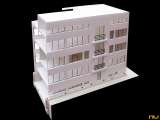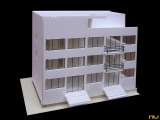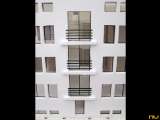
|

|

|

|

|

|
|
|
Dwelling building at Weissenhofsiedlung, plans |
|
In 1925, the Baden-Würtenberg branch of the Deustsche Werkbund appointed Mies the artistic director of a national housing exhibition to be held on Weissenhof hill, in the city of Stuttgart. The plot of land, elongated in shape and rugged in terrain, begins as a narrow stretch across from Friedrich-Ebert Street to the northeast and then broadens and rises slightly towards the southwest. Starting with this suggestive topography, Mies designed a set of volumes made up of interconnected houses, ‘like a mediaeval city’, which embrace the upper part of the hill, the site of a cluster of apartment buildings. This early proposal was criticised by the architects from the Deustsche Werkbund as being ‘romantic’, ‘unreal’ and ‘dilettante’. In the definitive version built in 1926, the majority of buildings were filtered through an orthogonal, simplified geometry.
Mies gave Le Corbusier a prominent place by locating his double house on the southwest end, the most visible part from the city. From there the houses designed by Hilberseimer, Poelzig, Döcker and Max Taut unfold following the mild slope of Rathenau Street heading northeast. On the southernmost point, running between Le Corbusier’s house and the house designed by Adolf Schneck, a staircase leads visitors to an inner street which serves as the backbone of the complex. The houses by Gropius, Max and Bruno Taut, Döcker and Rading are located on the eastern side, while the row houses by Oud and the apartment building designed by Mies himself are on the western side, the highest point on the street. The apartment building designed by Peter Behrens and the small home by Hans Scharoun are placed on the northern side of the land, while further down and northward the prototype by Josef Frank and the row houses by Mart Stam finish off the composition.
The elongated building by Mies, running north to south, contain 24apartments with six different designs laid out on four floors, with the terraces set aside for laundry and storage quarters. The building is entered through four staircases, each leading to two apartments. Mies advocated a regular structure and fluid space, a harbinger of his other subsequent projects. This led him to use a steel structure for the first time, whose outlines can be perceived in the rhythm of a facade supported on a foundation elevated above the gentle slope of the land. The structure is closed with a brick wall covered with a 4cm insulating panel clad, in turn, in plaster. Its resemblance to the linear Zeilenbau schemas – somehow denied at the start of the project – in which an egalitarian discourse prevails is proven through individual gardens and the layouts of the bathrooms, kitchens and staircases, closer to the 19th century patterns than to the spatial and functional challenges revealed in other projects in this development.
The inner partition walls away from the services are made of lightweight materials and are freely distributed, leading to the doors between rooms to be eliminated and flexible equipment to be added, designed by a broad group of architects and designers invited by Mies, including Lily Reich, Margarete Stolz and Arthur Korn.
|
|
DREXLER, Arthur (ed.), The Mies van der Rohe Archive. Nueva York & Londres: Garland, 1986 (4 vol.) COHEN, Jean-Louis. Mies van der Rohe. TraducciĂłn, Juan Calatrava Escobar. Madrid : Akal, 1998. (1Âş ed. Londres [etc.] : E. & F.N. Spon, 1996) SCHULZE, Franz. Mies van der Rohe. Una biografĂa crĂtica. Madrid: Hermann Blume, 1986. (1Âş ed. Mies van der Rohe. A critical Biography. Chicago & Londres: University of Chicago Press, 1985). SPAETH, David. Mies van der Rohe. Nueva York: Rizzoli, 1985. Ed. Castellano: Barcelona: G. Gili, 1985. NEUMEYER, Fritz; Mies van der Rohe: la palabra sin artificio, reflexiones sobre arquitectura : 1922-1968. TraducciĂłn de Jordi Siguán. Madrid : El CroquisDL, 1995 CARTER, Peter. Mies van der Rohe at work. Londres : Phaidon, 1999 (1Âş ed.1974) SAFRAN, Yehuda. Mies van der Rohe. Barcelona: Gustavo Gili, 2001. LAMBERT, Phyllis (ed.). Mies in America.Montreal: Centre Canadien d'Architecture, 2001. Chicago: Whitney Museum of Contemporary Art, 2001 |
|
|
Alvarez, Fernando. "Mies van der Rohe desde América" (Lectures of History of Art and Architecture, 2009). |






